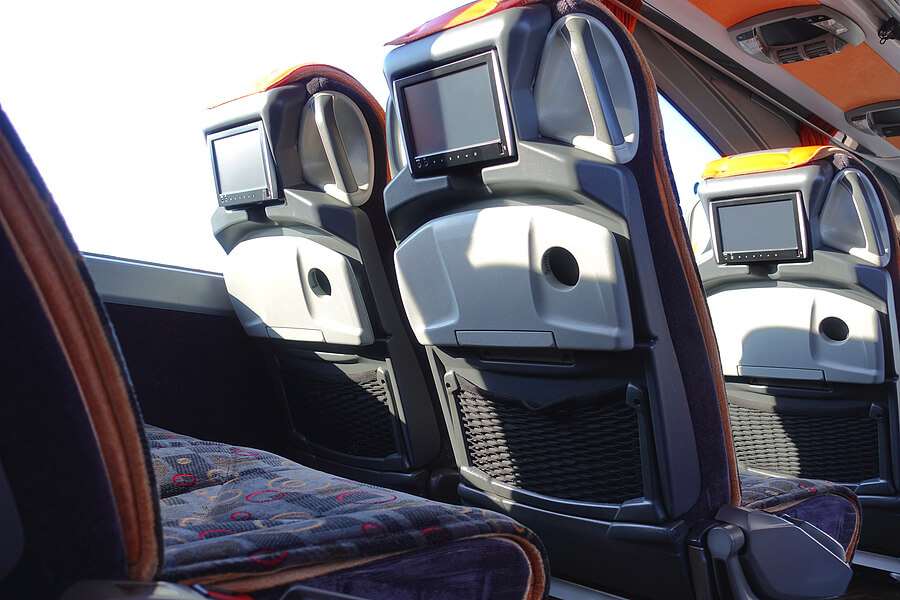Complete Guide to Charter Bus Manufacturers
When it comes to renting a bus, you have options. You can choose from many popular charter bus brands. Each brand is known for quality, dependability and luxury. Here are just a few of those brands:
- Motor Coach Industries (MCI)
- Van Hool
- Prevost
- TEMSA
Let’s take a closer look at these bus brands. You’ll discover what makes each one unique. We’ll also compare specs between their different coach models— so you can decide which bus is right for you! Partybuses.net offers more than 5,000 buses across the entire USA!
#1. MOTOR COACH INDUSTRIES (MCI)

Motor Coach Industries (MCI) is a multinational bus manufacturer that produces charter buses. The company has been in business for nearly 90 years. That makes them one of the largest and most-trusted bus providers in America. They sell more coaches than anyone else!
MCI has introduced many groundbreaking bus models. These buses are known for their quality, reliability, and comfort. They’ve earned a great deal of acclaim! In 2011, MCI public transportation coaches were reported to be 10 times more reliable than competitors!
About MCI
MCI’s story is inspirational! It’s a story of innovation and dedication to producing high-quality buses. The company also focuses on creating eco-friendly coaches that are built to last.
1933—Harry Zoltok owned a repair shop. He introduced a new 11-passenger vehicle design. This design was the beginning of MCI.
1937—The shop produced its first full line of coaches. These buses were built for Grey Goose Bus Lines (which later became a subsidiary of Greyhound Canada).
1939—Fort Garry released the Model 150. This transit bus was the first to use exterior stainless steel panels.
1941—Zoltok’s company officially became “Motor Coach Industries”. MCI started to make buses for the World War Instead of for itself.
1942—MCI designed and produced Canada’s first electric trolley bus. Sadly, it never went into regular production.
1945—MCI returned to manufacturing buses. Their first rear-engine coach, the Model 100, was produced.
1950s—Throughout the decade, MCI continued to innovate. They launched new models, including the “MC” series. The MC-1 was their first coach with a heating system!
1962—MCI began selling buses in the United States.
1958—The company produced the MC-6, which was the first 40-foot coach!
1978—The MC-9 Crusader II was produced. It soon became the best-selling model in North America.
1984—MCI became the first coach manufacturer to offer wheelchair lifts on its vehicles!
1990—The Americans with Disabilities Act was passed. MCI began producing a fully accessible coach with a wheelchair lift and an accessible restroom.
1994—MCI’s new MC-9 became the best-selling coach in North America.
1995—The MCI D-series was introduced. This coach could accommodate 55 passengers— thanks to its 45-foot length. It soon outsold the MC-9!
1997—MCI introduced the Renaissance model. This luxury coach had many high-end finishes, including a patented spiral entryway!
2000—New Jersey Transit paid $500 million for 1,400 of MCI’s commuter coaches. This was the largest coach transaction in history!
2001—The J4500 was introduced, which soon became a best-seller.
2002—MCI produced the first hybrid-electric commuter coach.
2007—MCI officially committed to producing “greener” transportation solutions. New models were released that produced smoke-free exhaust.
2010—MCI held the top 3 spots for the best-selling coach models.
2016—MCI was acquired by New Flyer. The company had a record-breaking production year, producing more than 3,500 units!
MCI Today
Today, MCI continues to innovate! They produce eco-friendly buses that are comfortable and reliable. MCI continues to build on their legacy of providing the best coaches in North America.
In 2018, MCI Executive VP Patrick Scully explained that charter buses must be affordable, sustainable, and scalable to meet the demands of customers. Luckily, MCI is achieving all three of those goals! They’re focusing on eco-friendliness, as well as luxurious interiors and dependability!
As of 2020, MCI has two new all-electric coaches in development. These coaches will have luxurious and reliable features. They’ll also boast fast-charging batteries and an impressive driving range!
MCI’S Available Buses
MCI manufactures 10 total coach models. Their coach models are in either the J-Series or the D-Series.
The J-Series has 45-foot and 35-foot coaches. The 45-foot coach can accommodate up to 60 passengers! It also has an expanded onboard restroom that you won’t find on other buses. The smaller 35-foot J3500 coach can accommodate up to 44 passengers.
The D-Series coaches are designed to be affordable without sacrificing performance or dependability.
MCI Bus Facts & Specs
| Model | Weight | Height | Width | Length | Seats | Luggage Compartment Volume | Fuel Tank Capacity |
| D45 CRT LE | 54,000 lbs | 138 in | 102 in | 45.58 ft | 54 | 135 cu ft | 183 gal |
| D4000 Commuter Coach | 46,000 lbs | 137 in | 102 in | 40.50 ft | 49 | N/A | 164 gal |
| D4505 | 50,000 lbs | 137 in | 102 in | 45.42 ft | 55 | 517 cu ft | 164 gal |
#2. VAN HOOL

Van Hool is a family-owned business in Belgium. They produce a variety of vehicles, including charter buses and public transit buses. Their buses are known for high-quality finishing touches and comfortable interiors! They also have unique features, like extra-tall front windows to improve visibility.
In recent years, Van Hool has focused on reducing its environmental impact. They’ve introduced a line of electric buses for both public and private transportation.
About VAN HOOL
Van Hool has a unique history. It began as a construction company!
1946—Bernard Van Hool needed a large vehicle to transport workers. He couldn’t find one, so he decided to build his own. He found an old bus and rebuilt it from scratch.
1948—Van Hool showcased their first line of vehicles!
1951—The company produced 10 buses for local Belgian transit.
1957—Van Hool signed an agreement with Fiat. This allowed them to incorporate Fiat engines and components into their coaches.
1965—Van Hool began producing industrial vehicles, including tankers and semi-trailers.
1966—The company began producing coaches for the United States.
1971—Van Hool established its first in-house welding school. This school still provides skilled labor training to Belgian workers today!
1979—Van Hool introduced the Acron. It became the company’s best-selling coach of all time!
1985—Van Hool began using computer-aided manufacturing to produce lighter, more efficient buses.
1987—The company signed an exclusive agreement with ABC Bus Companies to sell Van Hool coaches in the United States.
1995—Van Hool began experimenting with alternative fuels for its buses. They produced a hybrid midibus and a bi-mode trolley bus.
2005—Van Hool’s zero-emission, hydrogen-powered bus was incorporated into Dallas public transit.
2018—Construction began on a Van Hool factory in Tennessee. This factory will produce more tour buses for the North American market.
VAN HOOL Today
Today, Van Hool continues to innovate. They’re producing electric buses and developing new technologies to improve safety and comfort.
In response to the COVID-19 outbreak, Van Hool launched a new safety campaign. This campaign provides Van Hool owners with easy-to-install safety features! These features include a plastic divider between the driver and passengers, dividers between rows of seats, optimized HVAC hardware, air purifiers, removable seat covers, and hand sanitizer dispensers.
VAN HOOL’S Available Buses
Van Hool offers 11 charter bus models. Their bus models vary based on the needs and regulations of each continent. For example, their European bus models include midibuses. Midibuses are smaller than full-size charter buses but larger than minibuses.
In the North American market, Van Hool supplies a variety of larger bus models. These buses can accommodate 48-56 passengers and have plenty of luggage space!
VAN HOOL Bus Facts & Specs
| Model | Weight | Height | Width | Length | Seats | Luggage Compartment Volume | Parcel Rack Volume |
| TX Acron | 50,700-54,000 lbs | 12 ft., 3 in. | 8.4 ft. | 40-45 ft. | 48-56 | 384-440 cu. ft. | 58-109 cu. ft |
| CX45E | 50,700-54,000 lbs | 12 ft., 3 in. | 8.4 ft. | 40-45 ft. | 48-56 | 384-440 cu. ft. | 58-109 cu. ft. |
#3. PREVOST

Prevost is a French-Canadian charter bus company. They’re owned by Volvo and have a reputation for building coaches that are comfortable and easy to drive. They have great handling, ergonomic driver cockpits and luxurious interiors! Their coaches also have high ceilings, comfortable seating, and isolation from sound and vibrations!
If you need more proof that Prevost makes quality buses— they built the frames for Ground Force One! Ground Force One is the fleet of motorcoaches that are used to transport the President of the United States!
About PREVOST
Prevost began in 1924! Eugene Prevost was a cabinet-maker. He built a wooden coach body for an REO truck chassis. He did such a good job that he began manufacturing motorcoaches. Prevost was born!
1937-39—Prevost built its first bus manufacturing facility in Canada.
1951—Prevost manufactured 100 buses for the Canadian government.
1967—Prevost opened its first dealership in the United States.
1985—Prevost introduced its first H-series coach.
1995—Volvo and the Henlys Group bought Prevost.
1998—Prevost received an ISO 14001 certification for their environmentally-friendly practices.
2004—Volvo became the sole owner of Prevost.
2006—Prevost introduced the X3-45. This coach is more fuel-efficient and has more storage space than previous models.
2009—Prevost began selling Volvo 9700 coaches. They also updated their H-series bus with a new design and more storage space.
PREVOST Today
Prevost continues to improve its buses! They’ve also introduced new programs to make their buses safer.
In 2019, Prevost received a record-breaking contract from the New York City MTA. In 2020, they introduced new safety features for their buses, including eMirrors (electronic side mirrors) and the Driver Assist electronic system.
In 2020, Prevost created the Clean+Care program in response to the COVID-19 pandemic. This program helps to make Prevost buses safer for passengers and drivers.
PREVOST’s Available Buses
Prevost offers three motorcoach models. They also sell Volvo 9700 coaches. All of Prevost’s coaches have state-of-the-art features! Drivers can control many features from the steering wheel, and the steering wheel is ergonomically angled! Prevost coaches also have spacious interiors, noise and vibration isolation, and plenty of storage space.
Prevost uses Volvo D13 engines in their coaches. These engines are known for being energy-efficient. Prevost is the first and only North American bus manufacturer to receive an ISO 14001 certification for their environmentally-friendly practices!
H3-45
The H3-45 was Prevost’s first coach. It was first manufactured in 1985. The H3-45 is a luxury coach. It has comfortable seating, plenty of legroom, and panoramic windows. It also has the most storage space on the market!
X3-45
Prevost designed the X3-45 to be fuel-efficient. It also has a lower height than the H-Series coaches. Recently, the X3-45 was redesigned to make it more fuel-efficient. It now has 8-10% greater fuel efficiency.
X3-45 COMMUTER
Prevost designed the X3-45 Commuter for short daily trips. It’s a great option for employee shuttles! This coach has a smooth, quiet ride, has been tested on busy roads, and is fuel-efficient!
VOLVO 9700
Prevost sells Volvo 9700 coaches! These coaches are known for being safe. They also come in diesel, electric, and hybrid varieties. Volvo 9700 coaches are customizable. They can be ordered with additional passenger amenities, such as onboard entertainment systems!
#4. TEMSA

TEMSA is a Turkish bus manufacturer. Their factory in Adana produces coaches, midibuses, and light trucks. They’ve been in business for more than 50 years and have a reputation for building high-quality vehicles. TEMSA focuses on developing “smart” and eco-friendly transportation solutions.
About TEMSA
TEMSA was founded in 1968. They didn’t begin as a bus manufacturer, though. They supplied steel for the construction industry.
1968—The Sabancı family founded TEMSA.
1984—TEMSA began manufacturing buses and light trucks.
1987—TEMSA’s first coach bus, the Maraton, was introduced.
2000—TEMSA began exporting its vehicles to countries outside of Turkey.
2001—TEMSA released the Safari, its first independently-designed coach bus.
2004—The company began producing smaller buses, including midibuses.
2008—TEMSA introduced the Avenue city bus to the European market. That same year, they made their debut in the United States by selling the TS 35 coach bus.
2012—TEMSA began selling the TS30 and TS45 exclusively in the United States.
2016—TEMSA announced plans to open a manufacturing facility in the United States.
2019—TEMSA exhibited its first two electric buses, the MD9 electriCITY and the Avenue Electron. This marked TEMSA as the first company to have two electric buses ready for production.
2020—Sabancı Holdings and Škoda Transportation agreed to jointly own TEMSA.
TEMSA Today
Today, TEMSA is focusing on expanding its business in North America. They’re also investing more time and energy into developing their electric buses. TEMSA has four electric buses that will go into production soon.
TEMSA’S Available Buses
TEMSA offers a variety of bus models. The company produces coaches, city buses, and intercity buses. Their bus models vary based on the regulations and consumer needs of each region.
TEMSA currently sells three coach bus models in North America.
- TS 30 – a 30-foot model
- TS 35 – a 35-foot model
- TS 45 – a 45-foot model
TEMSA’S MOST POPULAR BUS MODEL: TS 45
The TS 45 is TEMSA’s most popular bus model in the United States. Many U.S. operators consider it to be a great value! It’s reliable, has a reasonable price point, and is affordable to operate!
TEMSA’S NEWEST BUS MODEL: TS 45E
The TS 45E is a fully electric version of the TS 45. Unfortunately, production was halted due to the COVID-19 pandemic.
TEMSA Bus Facts & Specs
| Model | Weight | Height | Width | Length | Seats | Luggage Compartment Volume | Fuel Tank Capacity |
| TS 30 | 27,980 lbs | 11 ft | 7.9 ft | 30 ft | 34 | 190 ft³ | 80 US gal |
| TS 35 | 37,448 lbs | 11.5 ft | 8.3 ft | 35 ft | 40 | 215 ft³ | 154 US gal |
| Maraton 13 | 18,000 – 19,000 kg | 3.9 m | 2.5 m | 13.08 m | 57+1 | 14 m³ | 583 L |
Partybuses.net Can Help You Book a Charter Bus
Partybuses.net works with a network of thousands of bus providers across the United States. We can help you find a coach from any of the four brands above— MCI, Van Hool, Prevost, or TEMSA. Whether you need a charter bus or a minibus, we’re here to help. We’ll make the bus rental process as easy as possible! We’re available 24/7 to answer your questions and provide you with a free quote.
Recent Posts
A First-Timer’s Guide to Booking a Charter Bus Rental
Best Things to Do with A Group in Las Vegas
Everything You Need to Know About Charter Bus Prices & How to Calculate Your Rental Costs
Guide to the Best Day Trips from Las Vegas
How to Sleep on a Charter Bus: Your Guide To Fall Asleep Easily
Our Favorite Books to Read on a Long Charter Bus Ride
Partybuses.net’s Favorite Stretches to Make Your Charter Bus Trip More Comfortable
